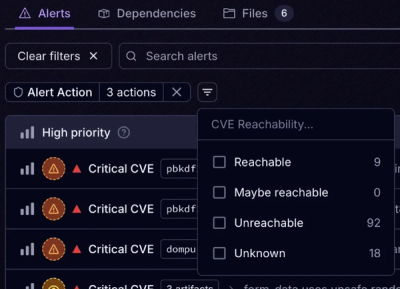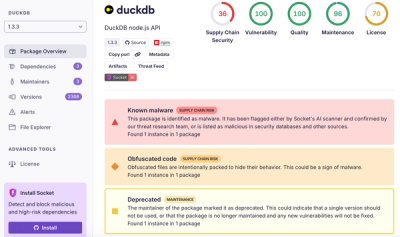
Product
Introducing Tier 1 Reachability: Precision CVE Triage for Enterprise Teams
Socket’s new Tier 1 Reachability filters out up to 80% of irrelevant CVEs, so security teams can focus on the vulnerabilities that matter.
fast-mapper
Advanced tools
fast-mapper makes it easy to map classes to plain objects and back using @decorators.
Why? Because solutions like class-transformer are verrrryyy slow when hydrating a lot of documents, and we want to do better... so use this instead!
@Decorator() based document mappingimport { Property, map } from 'fast-mapper';
import { ObjectId } from 'mongodb';
abstract class Base {
@Property({ type: ObjectIdType })
_id: ObjectId;
get id(): string {
return this._id.toHexString();
}
@Property()
createdAt: Date = new Date();
@Property()
updatedAt: Date = new Date();
}
Now create our document class with some fields.
import { Property } from 'fast-mapper';
import { BaseDocument, Address, Pet } from './models';
class User extends Base {
@Property()
name: string;
@Property(() => Address)
address: Address; // single embedded document
@Property(() => [Address])
addresses: Address[] = []; // array of embedded documents
@Property(() => [Pet])
pets: Pet[] = []; // array of discriminator mapped documents
@Property(() => Pet)
favoritePet: Pet; // single discriminator mapped document
@Property({ type: 'date' }) // "type" needs to be specified here due to reflection not seeing the Date[] since it's an array.
dates: Date[];
}
and here's the nested Address document.
import { Property } from 'fast-mapper';
class Address {
@Property()
city: string;
@Property()
state: string;
}
Now let's do some mapping...
import { map } from 'fast-mapper';
import { User } from './models';
const user = new User();
user.name = 'John Doe';
// ... populate the rest
/**
* Plain mapping (converts to destination mapping, including names)
*/
// converting to the mapped value as a plain object
const plain = map(User).toPlain(user);
// .. and convert back
const user = map(User).fromPlain(plain);
/**
* JSON mapping (keeps original property names)
*/
// convert to a JSON compatible type (useful for micro-service communication as an example)
const json = map(User).toJSON(user);
// .. and convert back
const user = map(User).fromJSON(json);
/**
* Instance Property Mapping (keeps original property names)
*/
// Alternatively, you can create a user via mapping:
const user = map(User).fromProps({ name: 'John Doe', /* ... */ });
// and if you want to convert a user to it's props (unmapped field names)
const props = map(User).toProps(user);
Types can be automatically discovered using reflection (reflect-metadata) and the Type.prototype.isType property,
however, if your property is an array, you must specify the type manually using @Property({ type: 'date' }) dates: Date[]
otherwise the values will not be mapped.
You can also create a custom type that extends Type (See types/DateType as an example).
To register your custom type, see the example below (these are also in tests/__fixtures__).
registerType(new ObjectIdType());
registerType(new UUIDType());
fast-mapper also has support for discriminator mapping (polymorphism). You do this
by creating a base class mapped by @Discriminator({ property: '...' }) with a @Property() with the
name of the "property". Then decorate discriminator types with @Discriminator({ value: '...' })
and fast-mapper takes care of the rest.
import { Discriminator, Property } from 'fast-mapper';
@Discriminator({ property: 'type' })
abstract class Pet {
@Property()
abstract type: string;
@Property()
abstract sound: string;
speak(): string {
return this.sound;
}
}
@Discriminator({ value: 'dog' })
class Dog extends Pet {
type: string = 'dog';
sound: string = 'ruff';
// dog specific fields & methods
}
@Discriminator({ value: 'cat' })
class Cat extends Pet {
type: string = 'cat';
sound: string = 'meow';
// cat specific fields & methods
}
And now, lets see the magic!
import { map } from 'fast-mapper';
import { User } from './models';
async () => {
const user = map(User).create({
name: 'John Doe',
address: {
city: 'San Diego',
state: 'CA'
},
addresses: [
{
city: 'San Diego',
state: 'CA'
}
],
pets: [{ type: 'dog', sound: 'ruff' }],
favoritePet: { type: 'dog', sound: 'ruff' }
});
console.log(user instanceof User); // true
const mapped = map(User).toPlain(user);
console.log(user instanceof User); // false
};
We wanted to make sure to keep library and user-land mapping separated, so consuming libraries can have their own mapping and type registration separate from a user's.
All you have to do to add mapping to your library is:
import { Mapper } from 'fast-mapper';
const mapper = new Mapper();
function Field(/* your options */): PropertyDecorator {
return (target: any, propertyName: string) => {
mapper.decorators.Property(/* map your options to Property options */)(target, propertyName);
}
}
For more advanced usage and examples, check out the tests.
FAQs
A JIT & decorator based class mapper focusing on performance
We found that fast-mapper demonstrated a not healthy version release cadence and project activity because the last version was released a year ago. It has 1 open source maintainer collaborating on the project.
Did you know?

Socket for GitHub automatically highlights issues in each pull request and monitors the health of all your open source dependencies. Discover the contents of your packages and block harmful activity before you install or update your dependencies.

Product
Socket’s new Tier 1 Reachability filters out up to 80% of irrelevant CVEs, so security teams can focus on the vulnerabilities that matter.

Research
/Security News
Ongoing npm supply chain attack spreads to DuckDB: multiple packages compromised with the same wallet-drainer malware.

Security News
The MCP Steering Committee has launched the official MCP Registry in preview, a central hub for discovering and publishing MCP servers.